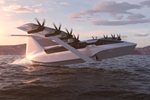Air-cushion barge serves ice, shallow water operations with infused carbon fiber propellor ducts
Four composite propellor ducts supplied by A C Marine & Composite drive forward the steel-built hybrid hovercraft design to provide essential services year-round in the North Caspian Sea.
A C Marine & Composites (Gosport, U.K.) has successfully supplied four infused carbon fiber propellor ducts for an air-cushion barge (ACB) contracted by Mangistau ACV Solutions (Athens, Greece), part of the CMI Offshore group (Vrilissia, Greece). The composites company designs and manufactures components for the tidal energy, marine, aerospace and defense sectors.
The barge itself is built of steel and powered by three lift fans, two marine propulsion units and three air propulsion ducted propellors. Able to carry more than 150 tons of cargo with sufficient fuel on board to enable 24-hour operations for up to four days at a time, it operates on a cushion of air — much like those employed in hovercraft — over water, ice, tundra, land or marsh, without damage to the environment. Compared to hovercraft, however, ACB is able to transport considerably higher payloads (with an all-up-weight of 900 tons), though at lower speeds; the weight is supported by a cushion of air that is contained within the flexible skirt underneath the structure and operates at an air pressure of only one pound per square inch. Part of this skirt is reinforced with steel for when it is operating over ice.
Designed and built by Mangistau ACV Solutions, with components delivered from suppliers in the U.K., Holland and Germany, the vessel reaches 56 meters in length, 24 meters in width, making it what Mangistau claims is the largest self-propelled air-cushion vessel in the world (including all previously built hovercraft).
Propellor duct units engineered by Gurit Composites Engineering (Wattwil, Switzerland) were built by A C Marine & Composites at its manufacturing site in Gosport, Hampshire, U.K. using the company’s advanced infusion technology. This helped achieve improved fiber volume fractions (FVCs) and a consistent, low-porosity matrix. Molds for the project were made in-house, using a KUKA (Augsburg, Germany) robot CNC milling machine and are themselves constructed with carbon fiber and a high glass transition temperature (Tg) tooling resin for high-temperature post cure while also maintaining accurate geometry.
Following completion of initial trials and certification, the ACB is expected to mobilize to the North Caspian Sea where it will conduct trials on ice. After successful completion of these trials it can then commence operations, providing essential services on a year-round basis on ice in the winter and shallow waters for the rest of the year. During the winter, experimental icebreaking will also be carried out using principles pioneered by hovercraft in other parts of the world.
Mangistau ACV Solutions is already working on the design of a series of larger vessels including versions designed to support the installation of offshore wind farms in shallow and tidal waters. Oil spill response in shallow waters and over ice as well as firefighting capabilities are also being explored.
Related Content
-
Plant tour: Spirit AeroSystems, Belfast, Northern Ireland, U.K.
Purpose-built facility employs resin transfer infusion (RTI) and assembly technology to manufacture today’s composite A220 wings, and prepares for future new programs and production ramp-ups.
-
Jeep all-composite roof receivers achieve steel performance at low mass
Ultrashort carbon fiber/PPA replaces steel on rooftop brackets to hold Jeep soft tops, hardtops.
-
PEEK vs. PEKK vs. PAEK and continuous compression molding
Suppliers of thermoplastics and carbon fiber chime in regarding PEEK vs. PEKK, and now PAEK, as well as in-situ consolidation — the supply chain for thermoplastic tape composites continues to evolve.

















